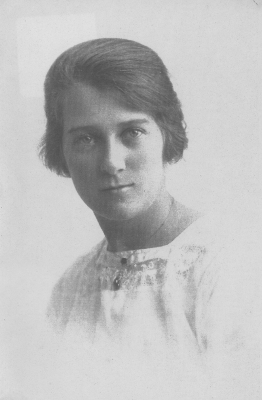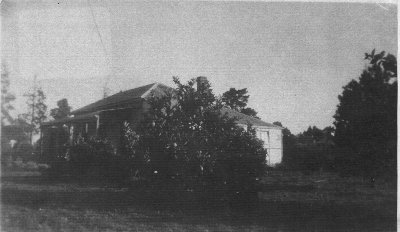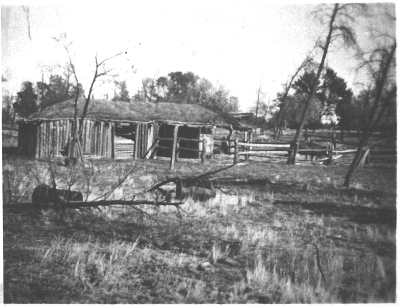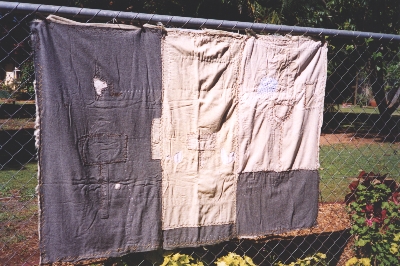Quilt No.915RH - Ruth Hansen
1700 x 1200mm
The quilt (called a 'Wagga' by the family) was made by Mathilde Laura (Tillie) Budich at Yarrara in north-west Victoria in the Mallee country called Millewa. It was made in the early 1940s. It is now owned by Tillie's daughter Ruth Hansen.
"Tillie Budich 1903-1994
Mathilde (Tillie) Laura Budich was born 24th February 1903 at Sedan, SA, the youngest daughter of Johann Gottlieb Heinrich and Bertha Christiane Nickolai (nee Kaesler).
When she was about 15, the family moved to Pata, near Loxton, SA, where the area was being opened up for farming. Tillie began to be in demand as a home help for local families, and developed skills that were to enhance her whole life.
She was married on 10th April 1929 to Charles William Budich, in St. Peter's Lutheran church in Loxton. The wedding actually took place in a terrible dust storm. Their wedding finery was so dust-drenched that they were not able to be photographed.
Bill had taken up a block of virgin land at Yarrara, in north-west Victoria in the Mallee country called Millewa. Establishing the farm was unimaginably hard work. Tillie was a loyal, loving help-mate to Bill in every way. They were blessed with four healthy children who remember a childhood filled with love, good friends, good food and laughter.
Tillie did most of the sewing for her family; in the early days with a hand-turned Singer machine. She only learned smocking and knitting when the youngest daughter, Joan was born. She also made bread, jams, preserves, pickles, sauces and quince jelly; soap, milked cows and made butter for sale, sold eggs and she and Bill salted and pickled meat in brine and made sausages, smoked ham and bacon.
I can remember flour bags being used for all manner of things, including the lining for my brother's school pants. Sugar bags were made into peg bags, oven cloths, pot holders, hard-wearing aprons and mats. Worn-out clothing was made into waggas. Fortunately one has survived even though I had to rescue it from a dog kennel. My sister Doreen and I slept on one over a horse hair mattress in our brass and enamel double bed with a rug of kangaroo skins over us.
Due to the Depression and a succession of droughts, many of the original settlers in the Millewa gave up the struggle of farming and left. Firstly there would be a 'clearing sale'. Many of our possessions were acquired that way,[including] a black leather covered settle. We children noticed a small three-cornered tear in the leather, and busy fingers soon explored. When Tillie found us with pretty fabric scraps, she washed and ironed them, and then started to enjoy a new artistic outlet. Some were big enough to make aprons for us, but most were made into patchwork covers for our beds. She cut diamond shapes and feather stitched these on to calico, making fabulous stars of colour.
In the early 50s because of a Government reallocation scheme for the district and to be near the water supply, Bill acquired and moved a disused house to the south end of the farm and this was renovated and enlarged. Bill was happy to be able to provide Tillie at last with a comfortable, spacious home with a hot water service and electricity. Tragically Bill died of a heart attack a fortnight before they were to move in. He was only 56. Tilly then made her life the farm, her family, friends, her church and the community. He son Don and brother-in-law Herbert worked the farm but she was always involved.
In the 80s when staying with her daughter Joan Apel at Gayndah, Qld, Joan introduced her to traditional patchworking and she was away! She had learnt 'real patchworking' at last! Mostly her work was log cabin with variations, some of it her own innovations.
In the 80s she watched me making a 'yo-yo' patch cover for a doll's cot and that started her on another quite enormous project. She began to make yo-yo bed covers for all the girls in the family and herself. We can be sure of 14 that she made in about 8 years. She actually wore out needles sewing all those circles! She liked the idea of using up all those small, odd shaped scraps.
Her 90th birthday was celebrated in her home on the farms. Her daughter Doreen and son-in-law Jack were share-farming at this time and caring for her. Still enjoying good health, she kept busy patchworking in every spare moment.
Sometimes it does not seem possible that our mother can be gone from this life. She seemed indestructible, or perhaps we hoped she was. She had lost her love, her mate Bill, far too early. She lost her son and her brother-in-law also too early. There were set backs including storms and fire damage, droughts, mouse plagues; grief, illness and pain, but she battled quietly through all those times and got on with her life. So many wonderful memories, and so many lovely things made with those busy hands. A whole life-time of loving and doing."
[Written by Ruth Hansen. Edited for length by Deirdre O'Donnell Sydney for NQR. Part of a longer story about the life of Tillie Budich held as primary material at NQR]




Related Quilts:
2125 x 1440mm
2743 x 1829mm
2299 x 1449mm
1570 x 1100mm
2415 x 2110mm








